Life Prediction of Penstock Based on Strength Simulation and Sediment Wear Test
Abstract
1. Introduction
2. Basic Parameters and Abrasion of Penstock in Hydropower Station
3. Stress Test of Load Rejection Penstock
3.1. Steel Pressure Pipe Stress Test System
3.2. Stress Test of Steel Pressure Pipe
4. Strength Mathematical Model Analysis of Load Rejection Penstock
4.1. Mathematical Model
4.2. Three-Dimensional Structure Modeling and Digital Model Meshing of Steel Pressure Pipe
4.3. Strength Mathematical Model Analysis of Penstock
5. Abrasion Test of Steel Pressure Pipe with Sediment
5.1. Numerical Simulation of Sand–Water Flow
5.1.1. Mathematical Model
5.1.2. Calculation Model and Grid Division
5.1.3. Numerical Calculation Results and Analysis
5.2. Testing System
5.3. Erosion Specimen and Test Section
5.4. Sediment Erosion Test and Result Analysis
6. Sediment Erosion and Life Prediction of Penstock
7. Conclusions
- (1)
- Stress testing was conducted on the load rejection penstock of the hydraulic turbine. A monitoring system for stress and strain in the steel pressure pipe was developed, providing real-time monitoring and a warning function. Load rejection tests were carried out at 25%, 50%, 75%, and 100%. The results showed that at 25% load rejection, the maximum volute pressure reached 0.575 MPa, and the maximum pipeline stress was 100.163 MPa. At 50% load rejection, the maximum volute pressure was 0.609 MPa, and the maximum pipeline stress was 104.556 MPa. For 75% load rejection, the maximum volute pressure reached 0.622 MPa, and the maximum pipeline stress was 104.215 MPa. Finally, at 100% load rejection, the maximum volute pressure was 0.620 MPa, and the maximum pipeline stress was 103.475 MPa.
- (2)
- A strength analysis of the hydraulic turbine load rejection penstock was conducted using a mathematical model. It was observed that the maximum equivalent stress of the steel pipe is 98.16 MPa with a 28 mm wall thickness, which increases to 115.22 MPa when the wall thickness is reduced to 24 mm. The maximum deformation of the steel pipe is 3.88 mm with a 28 mm wall thickness, and 4.41 mm when the wall thickness is reduced to 24 mm. The overall stress in the steel pipe is about 100 MPa with a 28 mm wall thickness and about 120 MPa when the wall thickness is 24 mm. The results from numerical simulations closely match the experimental findings, demonstrating the high accuracy of both the experimental and numerical simulation results.
- (3)
- Based on the material of the steel pipe and a safety factor ranging from 1.2 to 1.4, the results from the test and numerical simulations indicate that the maximum equivalent stress of the steel pipe should prompt a warning when it reaches around 120 MPa, with an alarm being triggered when it reaches about 140 MPa. This should be integrated into the monitoring system. The research confirms that with the current 28 mm wall thickness, the steel pipe will not fail under any load rejection conditions. However, if the wall thickness is reduced to around 24 mm, the maximum equivalent stress during load rejection will approach the safety limit.
- (4)
- A sediment erosion test was performed with an average sediment concentration of 0.63 kg/m3, resulting in an erosion rate of 3.509 × 10–5 mm/h. If no other factors, such as an increase in river sediment concentration, are considered, and based on the design requirements of the steel pressure pipe and the annual average sediment concentration of 0.63 kg/m3, the steel pressure pipe’s open section can theoretically be worn down to 24 mm and continue to operate for 19 years. It is advised that, once the wall thickness of the steel pipe reduces to around 24 mm due to erosion or other factors, the pipeline system should undergo more rigorous maintenance or replacement.
Author Contributions
Funding
Data Availability Statement
Conflicts of Interest
References
- Wan, W.; Zhang, B. Investigation of water hammer protection in water supply pipeline systems using an intelligent self controlled surge tank. Energies 2018, 11, 1450. [Google Scholar] [CrossRef]
- Ghidaoui, M.S.; Zhao, M.; McInnis, D.A.; Axworthy, D.H. A review of water hammer theory and practice. Appl. Mech. Rev. 2005, 58, 49–76. [Google Scholar] [CrossRef]
- Yu, X.; Zhang, J.; Zhou, L. Hydraulic transients in the long diversion-type hydropower station with a complex differential surge tank. Sci. World J. 2014, 2014, 241868. [Google Scholar] [CrossRef]
- Bergant, A.; Kruisbrink, A.; Arregui, F. Dynamic behaviour of air valves in a large-scale pipeline apparatus. Strojniški vestnik. J. Mech. Eng. 2012, 58, 225–237. [Google Scholar] [CrossRef]
- Huang, B.; Mao, L.; Zhang, Y.; Ren, J.; Zhang, M.; He, J.; Li, G. Microwave Sensing Vibration Measurement Technology and lts Applicationin Vibration Deformation Analysis of Hydraulic Turbine Penstock under the Action of Water Hammer. Water Power 2024, 50, 94–102. [Google Scholar]
- Shi, N.; Zhang, H.; Hu, H.; Sun, P.; Yu, J. Stress calculation method designed of pipeline in landslide section based on SBAS-Insar and finite element method[C]//New Horizon Educational Institution. In Proceedings of the 9th International Conference on Energy Materials and Environment Engineering (ICEMEE 2023), Kuala Lumpur, Malaysia, 8–10 June 2023. [Google Scholar]
- Zhu, M.; Lv, Y. Based on ANASYS with finite element analysis and calculation of cracked pipeline. Adv. Mater. Res. 2014, 989, 3185–3188. [Google Scholar] [CrossRef]
- Zhang, J.; Liang, Z.; Han, C.; Zhang, H. Buckling behaviour analysis of a buried steel pipeline in rock stratum impacted by a rockfall. Eng. Fail. Anal. 2015, 58, 281–294. [Google Scholar] [CrossRef]
- Liu, M.; Min, Y. Modeling the behavior of natural gas pipeline impacted by falling objects. Eng. Fail. Anal. 2014, 42, 45–59. [Google Scholar] [CrossRef]
- Bui, T.Q.; Jong-Myon, K. Crack detection and localization in a fluid pipeline based on acoustic emission signals. Mech. Syst. Signal Process. 2021, 150, 107254. [Google Scholar]
- Li, Y.; Zhang, J.; Xu, H.; Bai, Y. Experimental study on the characteristics of sediment transport and sorting in pressurized pipes. Water 2021, 13, 2782. [Google Scholar] [CrossRef]
- Wang, H.; Pang, J.; Liu, X.; Zhou, Z.; Gang, Y.; Lai, Z.; Wang, J.; Qin, B. Analysis on cause of erosion of guide vane of high-head Francis turbine in sandy river. Energy Sci. Eng. 2024, 12, 3704–3717. [Google Scholar] [CrossRef]
- Li, S.; Yao, B.; Pang, J.; Liu, D.; Chengmei, D.; Jiang, D.; Wang, H.; Gang, Y.; Cheng, H.; Liu, X. Research on the technical improvement of the turbine runner of a power station based on improving stability. Energy Sci. Eng. 2024, 12, 4582–4597. [Google Scholar] [CrossRef]
- Yao, B.; Gang, Y.; Xiao, M.; Yu, Z.; Jiang, D.; Pang, J.; Liu, X. Influence of tungsten carbide spray treatment on anti-erosion performance of Francis turbine runner blades surface. Adv. Mech. Eng. 2024, 16. [Google Scholar] [CrossRef]
- Pang, J.; Liu, H.; Liu, X.; Yang, H.; Peng, Y.; Zeng, Y.; Yu, Z. Study on sediment erosion of high head Francis turbine runner in Minjiang River basin. Renew. Energy 2022, 192, 849–858. [Google Scholar] [CrossRef]
- Rohit, S.K.; Bhupendra, G.K. Erosive flow field investigation on guide vanes of Francis turbine—A systematic review. Sustain. Energy Technol. Assess. 2022, 53, 102491. [Google Scholar]
- Shrestha, U.; Chen, Z.; Park, H.S.; Choi, Y.D. Numerical studies on sediment erosion due to sediment characteristics in Francis hydro turbine. IOP Conf. Ser. Earth Environ. Sci. 2019, 240, 042001. [Google Scholar] [CrossRef]
- Thapa, S.B.; Dahlhaug, G.O.; Thapa, B. Sediment erosion in hydro turbines and its effect on the flow around guide vanes of Francis turbine. Renew. Sustain. Energy Rev. 2015, 49, 1100–1113. [Google Scholar] [CrossRef]
- Liu, X. Study on turbulent solid-liquid two-phase flow and erosion in turbine. J. Hydrodyn. (A Ser.) 1996, 606–609. Available online: https://www.zhangqiaokeyan.com/academic-journal-cn_chinese-journal-hydrodynamics_thesis/0201273871780.html (accessed on 2 January 2025).
- Liu, X.; Zeng, Y.; Hua, H.; Yu, Z.; Pang, J.; Tian, C. study on sediment abrasion of turbine runner blades in Yuzixi hydropower station. J. Xihua Univ. (Nat. Sci. Ed.) 2020, 39, 67–73. [Google Scholar]
- Xiao, Y.; Wang, Z.; Yan, Z.; Luo, Y.; Xiao, R.; Peng, G.; Xue, P. Experimental and numerical analysis of pressure pulses characteristics in a Francis turbine with partial load. IOP Conf. Ser. Earth Environ. Sci. 2010, 12, 012023. [Google Scholar]
- Li, Y.; Guo, B.; Xiao, Y. Simulation study on sediment erosion characteristics of high head Francis turbine runner. J. Hydropower Gener. 2020, 39, 112–120. [Google Scholar]
- Ge, X.; Sun, J.; Li, Y.; Wu, D.; Zhang, L.; Hua, H. Numerical simulation of sand abrasion characteristics of jet mechanism of impulse turbine. J. Hydraul. Eng. 2020, 51, 1486–1494. [Google Scholar]
- Ge, X.; Sun, J.; Li, Y.; Zhang, L.; Deng, C.; Wang, J.; Gao, F.; Ding, M.; Zheng, Y. The erosion characteristics of the diameter and concentration of sediment on the runner of bucket water turbine. Proc. Chin. Soc. Electr. Eng. 2021, 41, 1–13. [Google Scholar]
- Ge, X.; Sun, J.; Cai, J.; Zhang, L.; Zhang, H.; Wang, J.; Maxime, B.; Zheng, Y. Research on the influence of abrasion on the bucket profile and performance of bucket turbines. Proc. Chin. Soc. Electr. Eng. 2021, 41, 6–26. [Google Scholar]
- Yang, H.; Liu, X.; Tian, W.; Pang, J.; Xu, L. Sediment Abrasion of Turbine Guide Vanes at Xiate Hydropower Station in Xinjiang. J. Chin. Soc. Power Eng. 2022, 42, 190–196. [Google Scholar]
- Yang, H. Calculation of Sand-Water Flows in the Francis Turbine of Xiate Power Station and Study om Sediment Erosion of Sprayed Tungsten Carbide Guide Vanes. Master’s Thesis, Xihua University, Chengdu, China, 2023. [Google Scholar]
- Zhao, X.; Liu, X.; Chen, J.; Yang, J.; Pang, J. Sediment erosion of hydraulic turbine moving guide vane at Ying xiuwan Hydropower station. Chin. J. Hydrodyn. 2021, 36, 728–734. [Google Scholar]
- Fang, X.; Yu, Z.; Liu, X. Research on Sediment Erosion of Turbine Guide Vanes in High Head Sediment-Laden Power Station. Yellow River 2019, 41, 121–124. [Google Scholar]
- Zhao, X.; Peng, Y.; Yang, J.; Ren, M.; Liu, X. Experimental analysis of the effect of erosion factors on guide vane of hydraulic turbine. Machines 2022, 10, 264. [Google Scholar]
- Liu, X.; Cheng, L. A k-ε two-equation turbulence model for solid-liquid two-phase flows. Appl. Math. Mech. 1996, 17, 76–86. [Google Scholar]
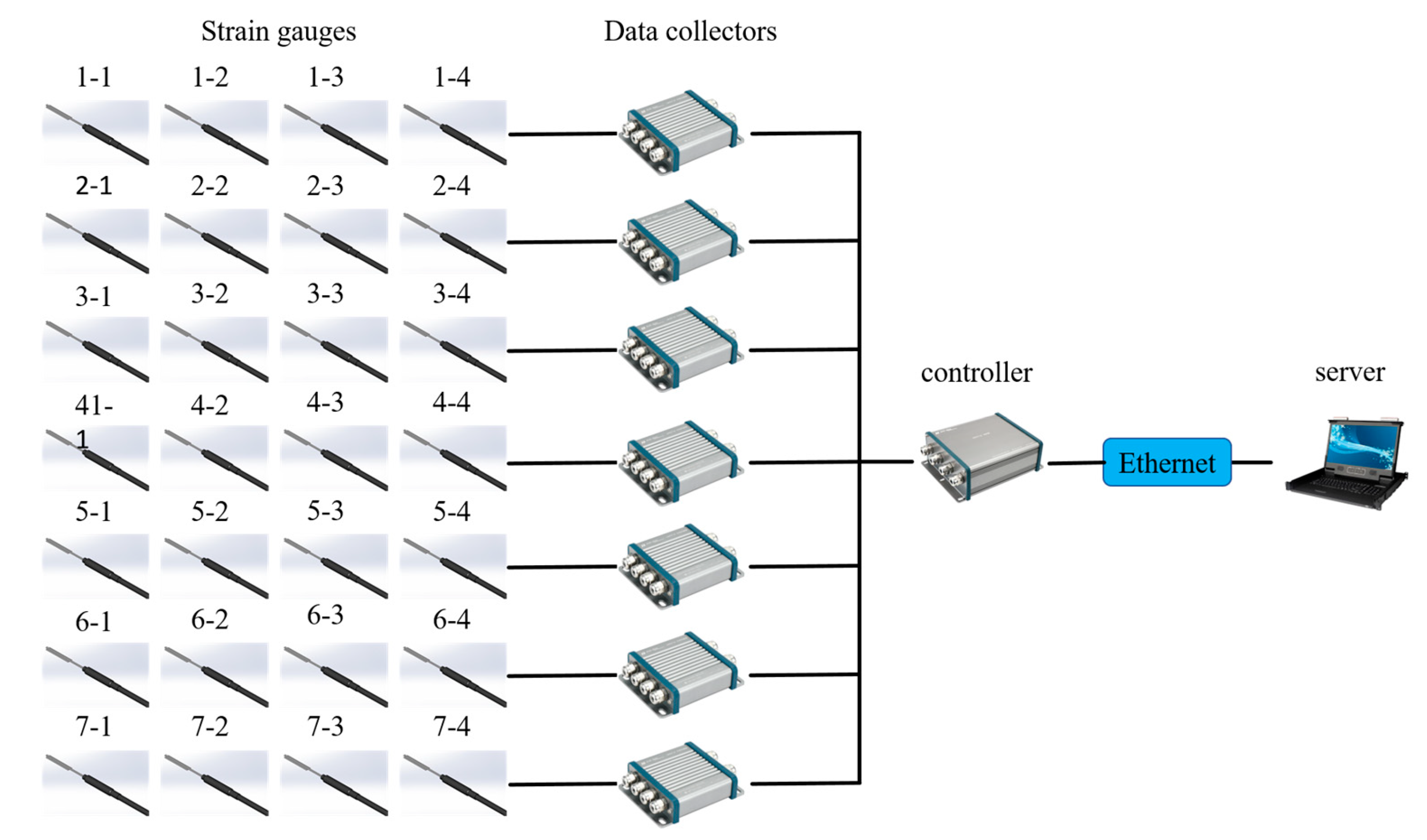
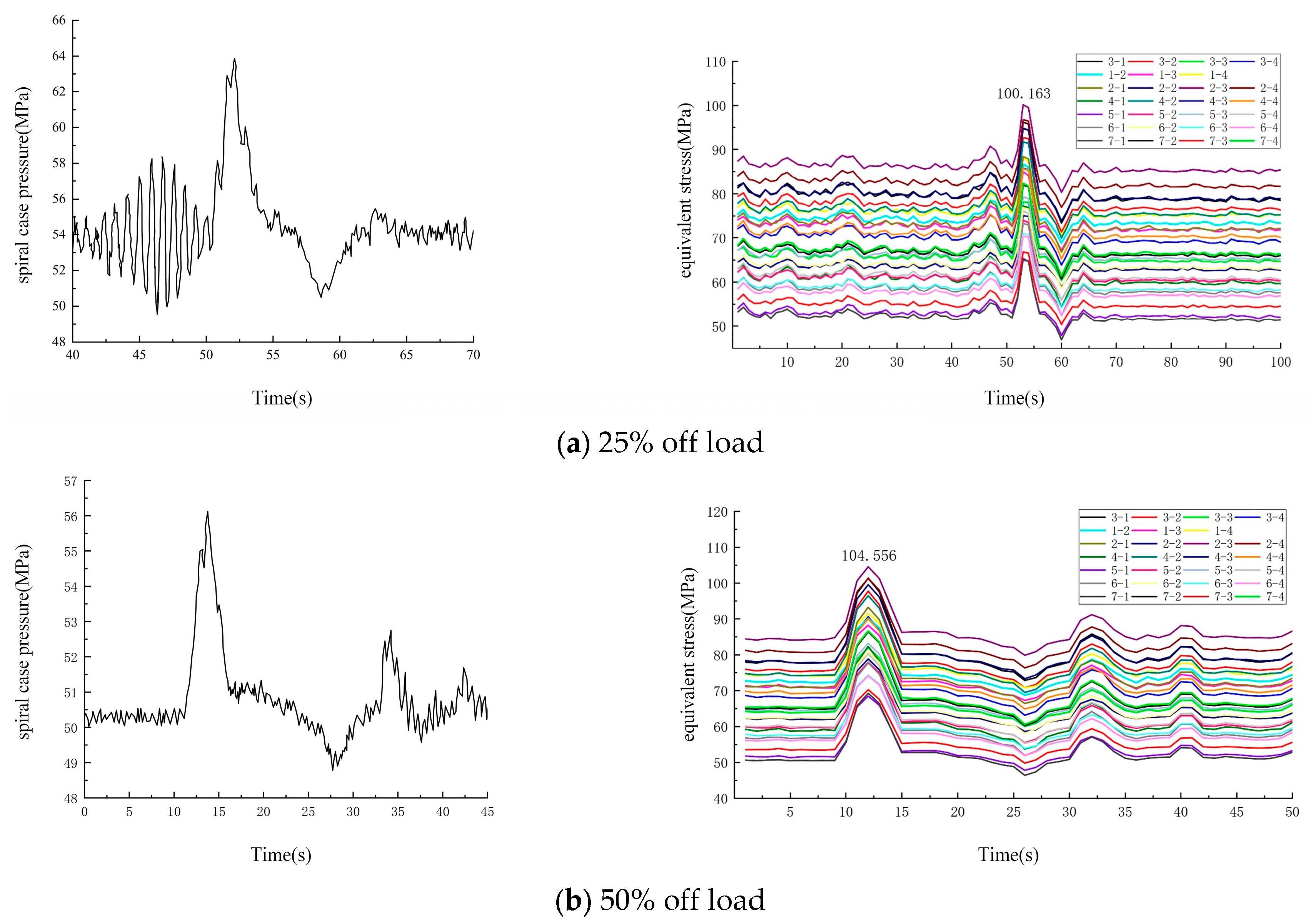
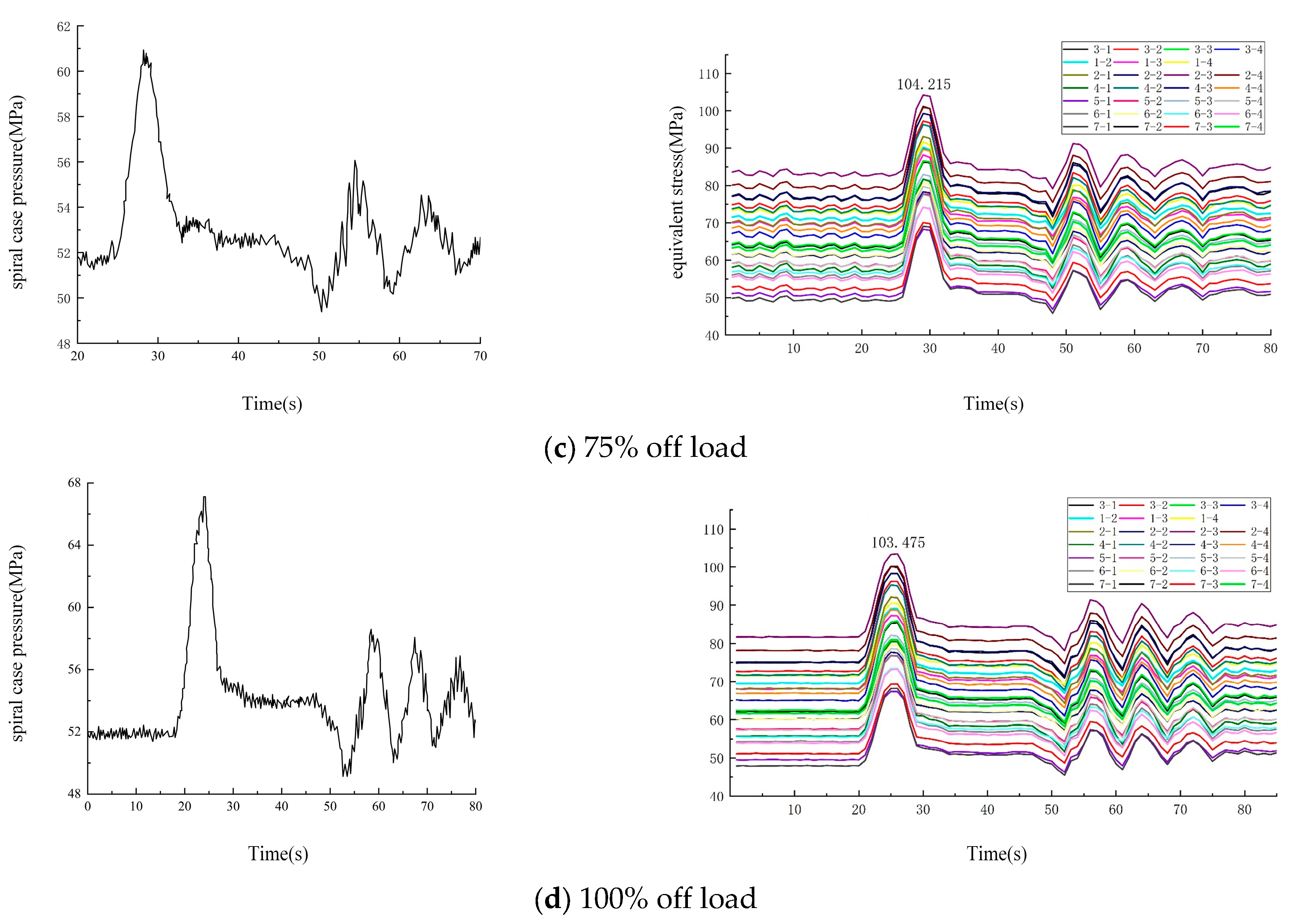

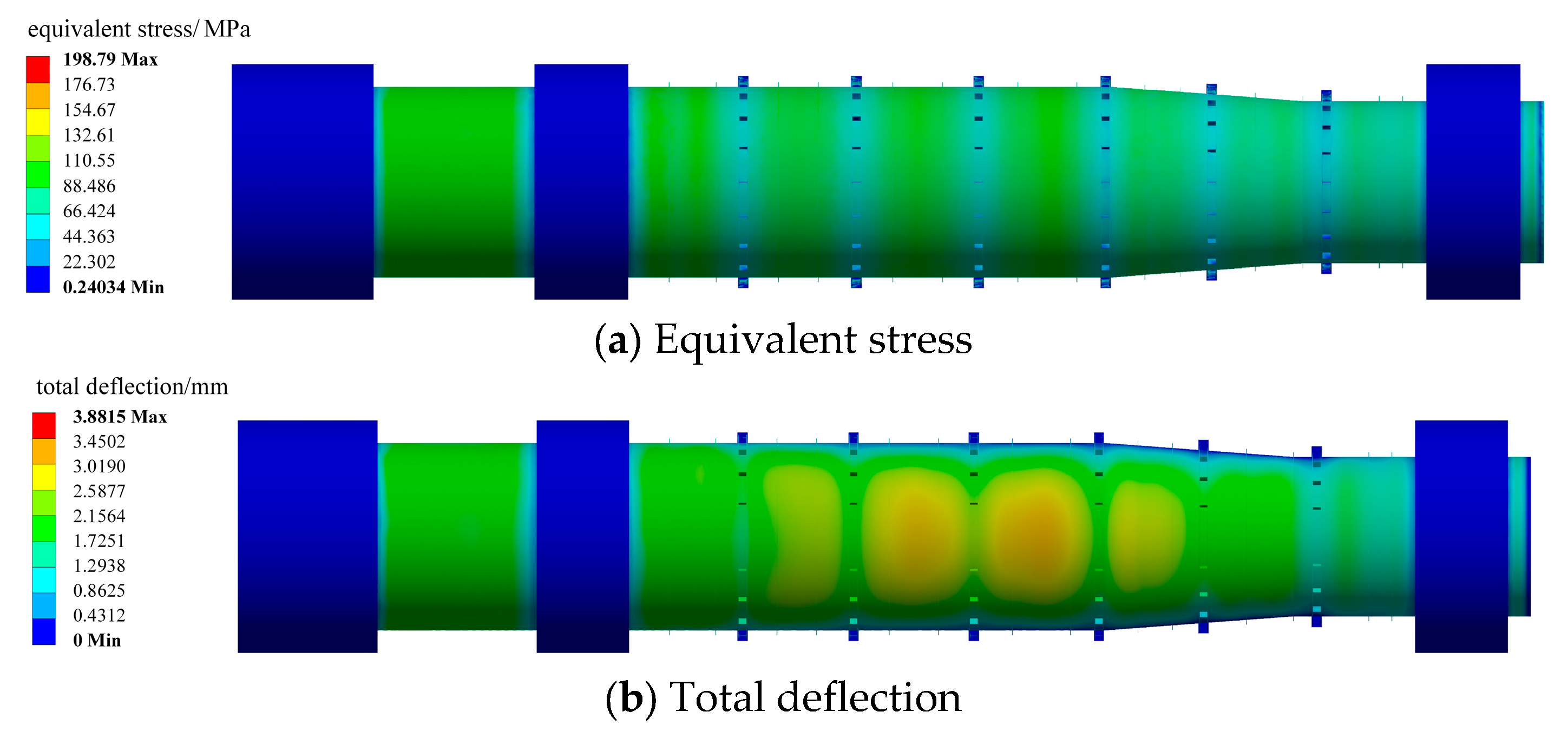
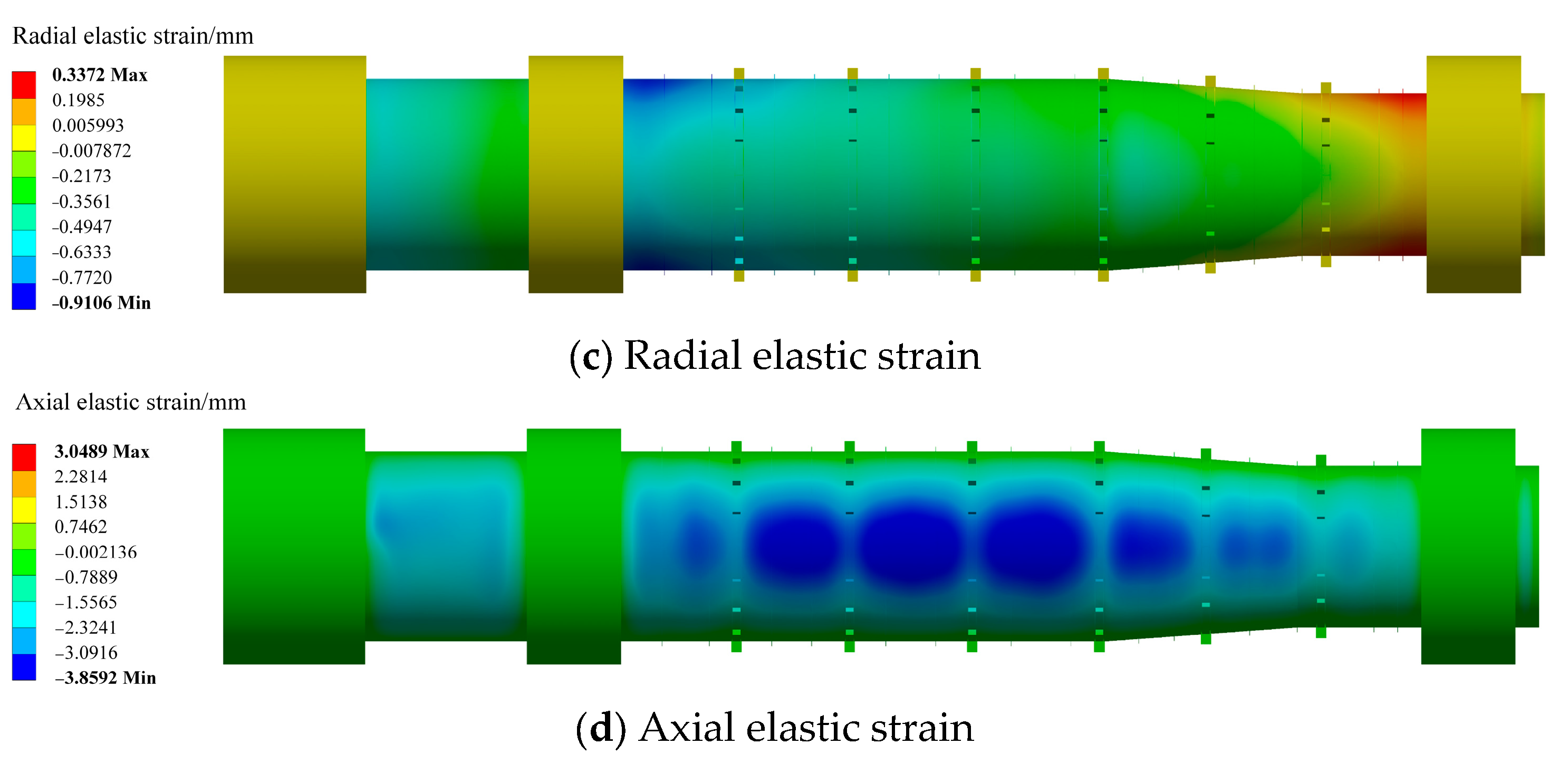

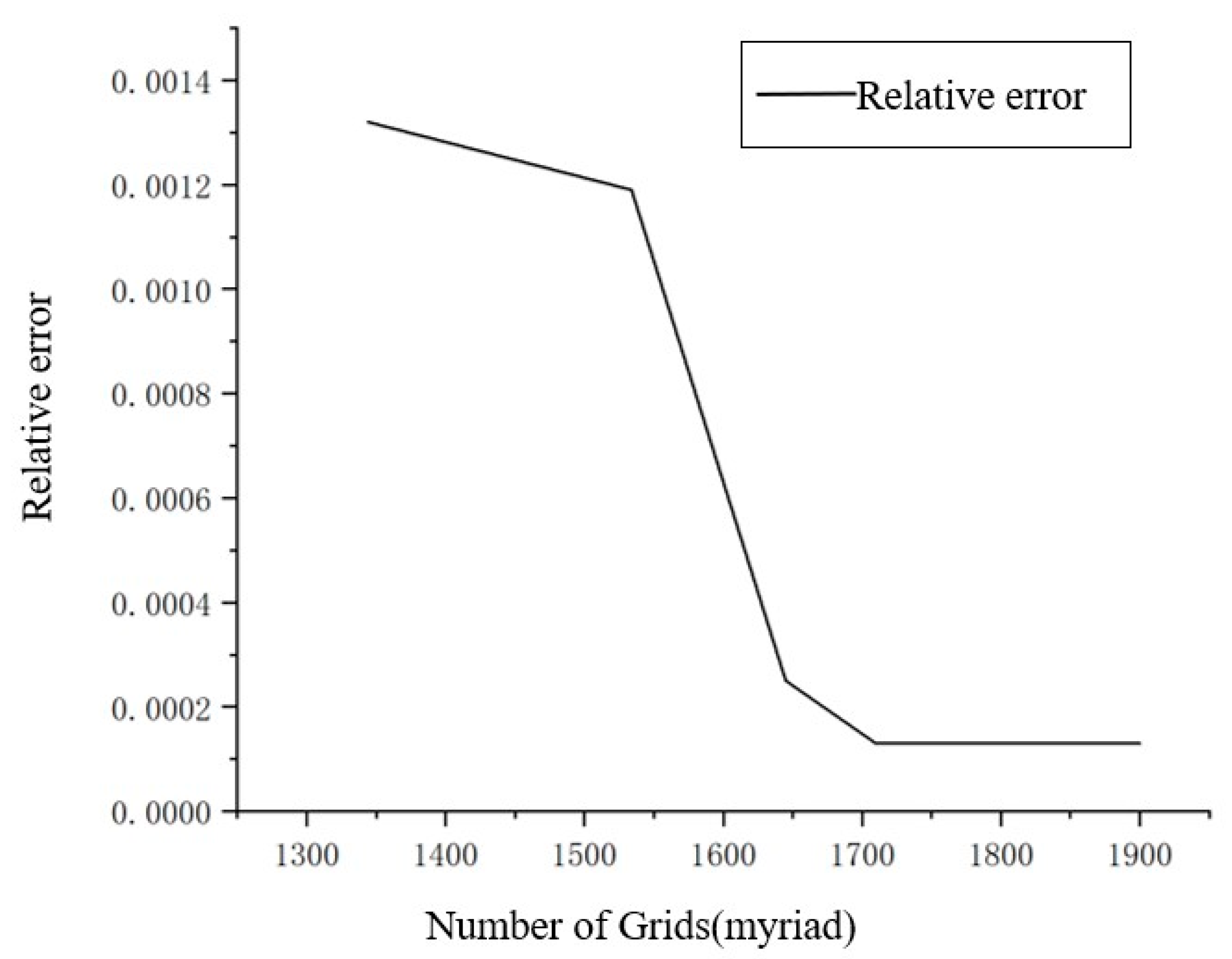





| Name of the Material | Density (kg/m3) | Elastic Modulus (GPa) | Poisson Ratio | Yield Strength (MPa) |
|---|---|---|---|---|
| 15 Mn | 7850 | 210 | 0.3 | 245 |
| Concrete | 2392 | 22 | 0.1414 | 30 |
| Total Deflection (mm) | Equivalent Stress (MPa) | |||
|---|---|---|---|---|
| Steel Thickness | 28 mm | 24 mm | 28 mm | 24 mm |
| Monitoring point 1 | 2.231 | 2.717 | 97.731 | 115.22 |
| Monitoring point 2 | 2.987 | 3.411 | 93.981 | 109.42 |
| Monitoring point 3 | 3.674 | 4.154 | 92.823 | 108.76 |
| Monitoring point 4 | 3.877 | 4.406 | 94.851 | 113.24 |
| Monitoring point 5 | 3.787 | 4.314 | 98.164 | 114.38 |
| Monitoring point 6 | 3.358 | 3.711 | 85.267 | 99.121 |
| Monitoring point 7 | 2.929 | 3.295 | 80.482 | 97.204 |
| Monitoring point 8 | 2.039 | 2.679 | 76.871 | 89.839 |
| Parameter | Value |
|---|---|
| Number of nodes (ten thousand) | 1696 |
| Number of grids (ten thousand) | 1710 |
| First layer mesh size (mm) | 0.88 |
| Growth rate | 1.3 |
| Mesh quality | 0.7~1 |
| Maximum length–width ratio | 52 |
| Parameter | Value |
|---|---|
| Inlet velocity V (m/s) | 5.77 |
| Outlet pressure P (KPa) | 430 |
| Design flow Q (m3/s) | 290 |
| Design head H (m) | 44 |
| The average sediment concentration Cv (kg/m3) in flood season | 2.5 |
| Running Time (Years) | Present | 1 | 5 | 10 | 19 |
|---|---|---|---|---|---|
| The amount of erosion on the inner wall of the tube (mm) | 0.211 | 1.053 | 2.105 | 4.000 | |
| Wall thickness (mm) | 28.000 | 27.790 | 26.948 | 25.895 | 24.000 |
Disclaimer/Publisher’s Note: The statements, opinions and data contained in all publications are solely those of the individual author(s) and contributor(s) and not of MDPI and/or the editor(s). MDPI and/or the editor(s) disclaim responsibility for any injury to people or property resulting from any ideas, methods, instructions or products referred to in the content. |
© 2025 by the authors. Licensee MDPI, Basel, Switzerland. This article is an open access article distributed under the terms and conditions of the Creative Commons Attribution (CC BY) license (https://creativecommons.org/licenses/by/4.0/).
Share and Cite
Peng, L.; Pang, J.; Zhou, Z.; Wang, H.; Li, S.; Xiang, W.; Yi, X.; Liu, X. Life Prediction of Penstock Based on Strength Simulation and Sediment Wear Test. Processes 2025, 13, 414. https://doi.org/10.3390/pr13020414
Peng L, Pang J, Zhou Z, Wang H, Li S, Xiang W, Yi X, Liu X. Life Prediction of Penstock Based on Strength Simulation and Sediment Wear Test. Processes. 2025; 13(2):414. https://doi.org/10.3390/pr13020414
Chicago/Turabian StylePeng, Liang, Jiayang Pang, Ziyao Zhou, Haiqi Wang, Shenhui Li, Wenping Xiang, Xutao Yi, and Xiaobing Liu. 2025. "Life Prediction of Penstock Based on Strength Simulation and Sediment Wear Test" Processes 13, no. 2: 414. https://doi.org/10.3390/pr13020414
APA StylePeng, L., Pang, J., Zhou, Z., Wang, H., Li, S., Xiang, W., Yi, X., & Liu, X. (2025). Life Prediction of Penstock Based on Strength Simulation and Sediment Wear Test. Processes, 13(2), 414. https://doi.org/10.3390/pr13020414





